Are you looking for a race that blends scenic beauty with small-town charm? What about a course that makes you want to stay long after you cross the finish line? Look no further than IRONMAN 70.3 Musselman, a gem tucked into the heart of New York’s Finger Lakes region which ranks among the world’s top 70.3 races.
Set against a backdrop of vineyards, rolling hills, and lakefront views, Musselman offers more than just a fast and scenic course. With plenty to explore throughout the Finger Lakes, Musselman is the perfect excuse for a “race-cation” with family or friends.
We chose Musselman 70.3 as a mid-summer adventure that will certainly stand out as one of our most memorable race experiences. Here is our race report for IRONMAN 70.3 Musselman.
About IRONMAN 70.3 Musselman
Musselman 70.3 is based in Geneva, New York, in the Finger Lakes.
Racers swim in the crystal-clear waters of Seneca Lake, before cycling across open countryside, rolling hills, and alongside several of the nearby lakes, and finish up on a mostly flat run through town. Recently, this race won several of the 2024 Ironman Athlete’s Choice Awards, such as #1 best race and #1 best bike, both globally for 70.3 races.
Historically, athletes can expect a wetsuit-legal swim, with an average water temperature of 72 °F (22 °C), along with warm weather and an average high air temperature of 84 °F (29 °C). We were not so lucky. Strong winds and hot summer air blew into the area a few days before the race, leading to hotter-than-average temperatures, along with some insanely choppy water. These conditions made for a much more challenging race than we expected.
The surrounding Finger Lakes region is home to wine country, along with plenty of scenic hiking trails and charming towns to explore. These make Musselman 70.3 a great choice for a “race-cation.” After your race, take it slow and tour the region’s top wineries, loosen the legs on a number of great hiking trails, and enjoy the natural beauty of the Finger Lakes.
We recommend racing Musselman 70.3 Despite our poor weather conditions, we still enjoyed racing on a beautiful course full of great spectator and volunteer support and enjoyed touring the Finger Lakes for several days following the race.
Historical Weather Data
2025: High Temperature: 90°F (Heat Index: 101°F); Low Temperature: 77°F; Wind: 10 mph; Water Temperature: 79°F
2024: High Temperature: 83°F; Low Temperature: 63°F; Water Temperature: 76°F
2023: High Temperature: 79°F; Low Temperature: 64°F; Water Temperature: 76°F
Pre-Race in Geneva
We arrived in Geneva on Friday afternoon, two days before Sunday race day. We checked in at the Ironman village shortly after we arrived, got our race gear, and spent some time shopping for Ironman merch. Most athletes arrived on Saturday, so we were able to claim a lower race number along with a better spot in transition.
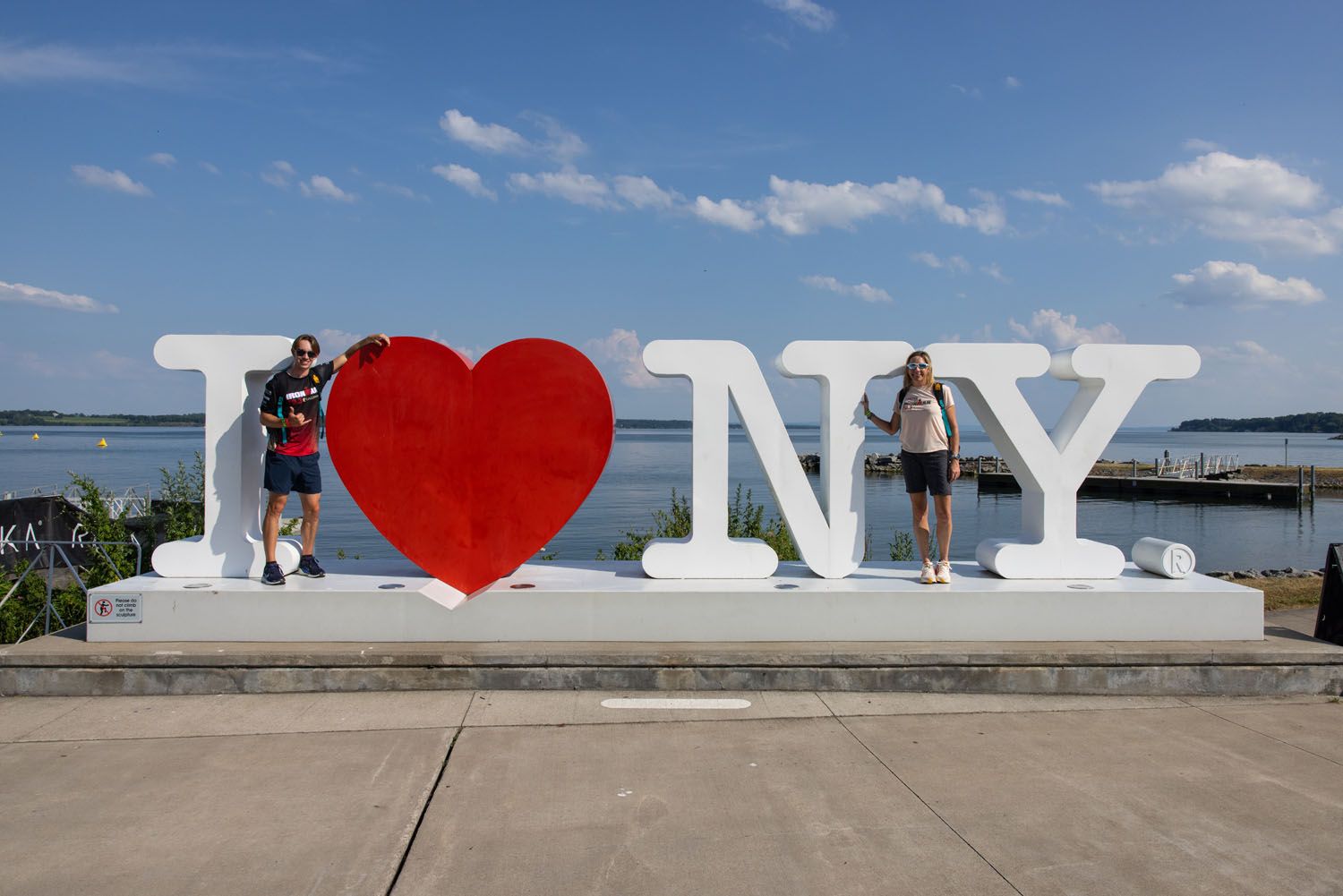
We stayed in the Hampton Inn Geneva, which was great for its close location to both transition and nearby restaurants. With a 5-minute walk to transition, we loved having easy access to the Ironman village. This meant we could sleep in later on race morning, and head back to take post-race showers before the award ceremony started.
The day prior to the race was for scouting the course, getting some final training in, and calming the nerves before tomorrow’s big day. Strong winds hit the area overnight, turning the once calm waters of Seneca Lake into a brutal washing machine. We stood at the shore in a mix of awe and fear of how dramatic the swimming conditions were. We could even see whitecaps breaking from the waves, not something you expect for a lake swim.
We completed a short practice swim, getting trashed by the waves as we struggled to swim in a straight line. I’d go to breathe on my side and be met with a wave, inhaling a mouthful of lake water, or I’d look forward to sight and see nothing but the crest of the wave in front of me. Maybe it was because there were no stakes on our practice swim, but I found this to be quite a good bit of fun, but most importantly, good practice for tomorrow.
We racked our bikes in transition that afternoon, I met one of my AP Racing teammates, and spent the rest of the day hydrating, fueling up with a delicious dinner at Kindred Fare, and doing our best to keep the nerves away. Today however, I felt calm and confident. I had been doing a lot more training leading up to the race and was coming off a stellar performance at Eagleman 70.3 the month prior. I felt strong on my swim, bike, and run, and was ready to crush it on the course the following morning.
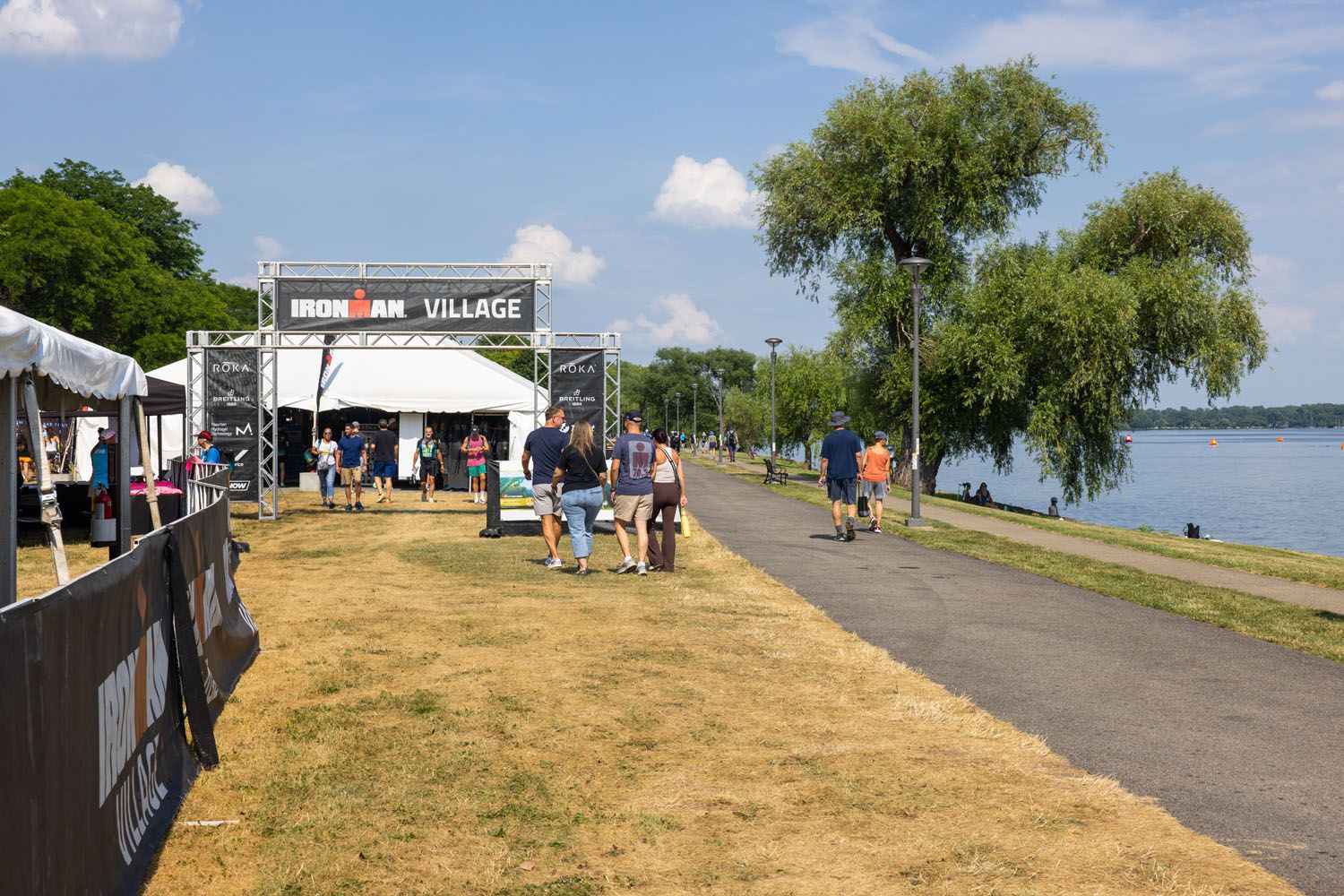
Ironman Village. On race day, the path on the far right of the photo is part of the run course. You can also see the swim buoys on the lake. This photo was taken Friday afternoon, 2 days before race day.

Lake Geneva (swim course; photo taken on Friday when it was very calm and more typical of past race conditions)
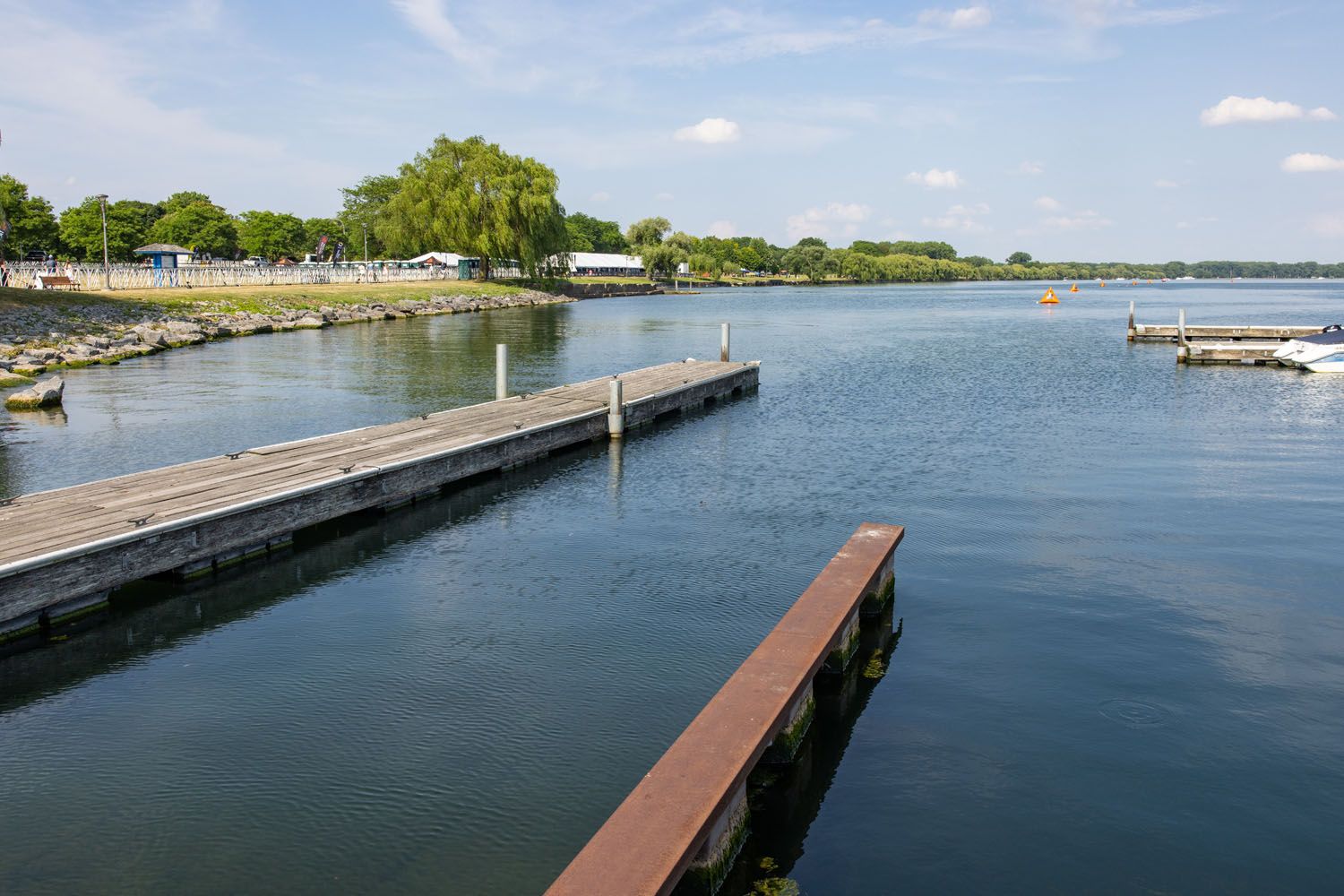
The swim exit with Ironman Village in the background
Race Report
Tim, Julie, and I all raced Musselman in 2025. This is my (Tyler’s) race report.
The Swim: 1.2 Miles
It was already 77 degrees and very muggy when we stepped outside our hotel at 5 am. The sun hadn’t even risen yet. Today was going to be a hot day for sure. I mentally prepared myself for that, but didn’t dwell on it, as there was nothing I could control. Everyone would be racing in the same conditions. We made the last few adjustments to our transition setup and did our best to keep the nerves at bay.
It was finally time to join the swim corral. The masses bunched up within the starting chute by the water, and I squeezed my way through to the 38-40 minute section. It was an ambitious time for me, but I was hoping I could start on a faster swimmer’s feet and use their draft.
Looking out at the water, I knew we were in for a crazy race. The water was just as rough as yesterday, with extremely choppy water that even had the support kayakers struggling in the water. I heard a rumor that race directors considered shortening the swim, concerned about the kayakers being able to hold their position, but the final decision was to swim the full course.
To get me in the right headspace, I looked out at the water and treated it like a challenge. Everyone had to swim in the same conditions, and it’s not everyday you get to race in choppy water like this, so I was going to make the most of it. I was oddly excited about starting and welcomed the challenge!
As soon as I hit the water, I was in my element. I kept my stroke rate high to better combat the choppy conditions, and soon situated myself amidst the pack. I didn’t worry about drafting; the conditions just made it a nightmare. Mentally I was calm, focused, and strangely enough, having fun!
Breathing and sighting ended up being large problems given how rough the water was. With all the chop, I had to sight multiple times to see the buoy, as most times all I’d see was the wave in front of me blocking my view. The waves were pulling me all over the place too, where at times I questioned if I was even moving forward. As far as water visibility, the choppiness made it murkier than usual, but you could clearly see other swimmers when looking to the side.
Note: We learned later that about 22% of all athletes DNF’d in this race. Typical numbers are around 4%. We even heard from a volunteer that over 30 swimmers had to be rescued and brought back to shore.
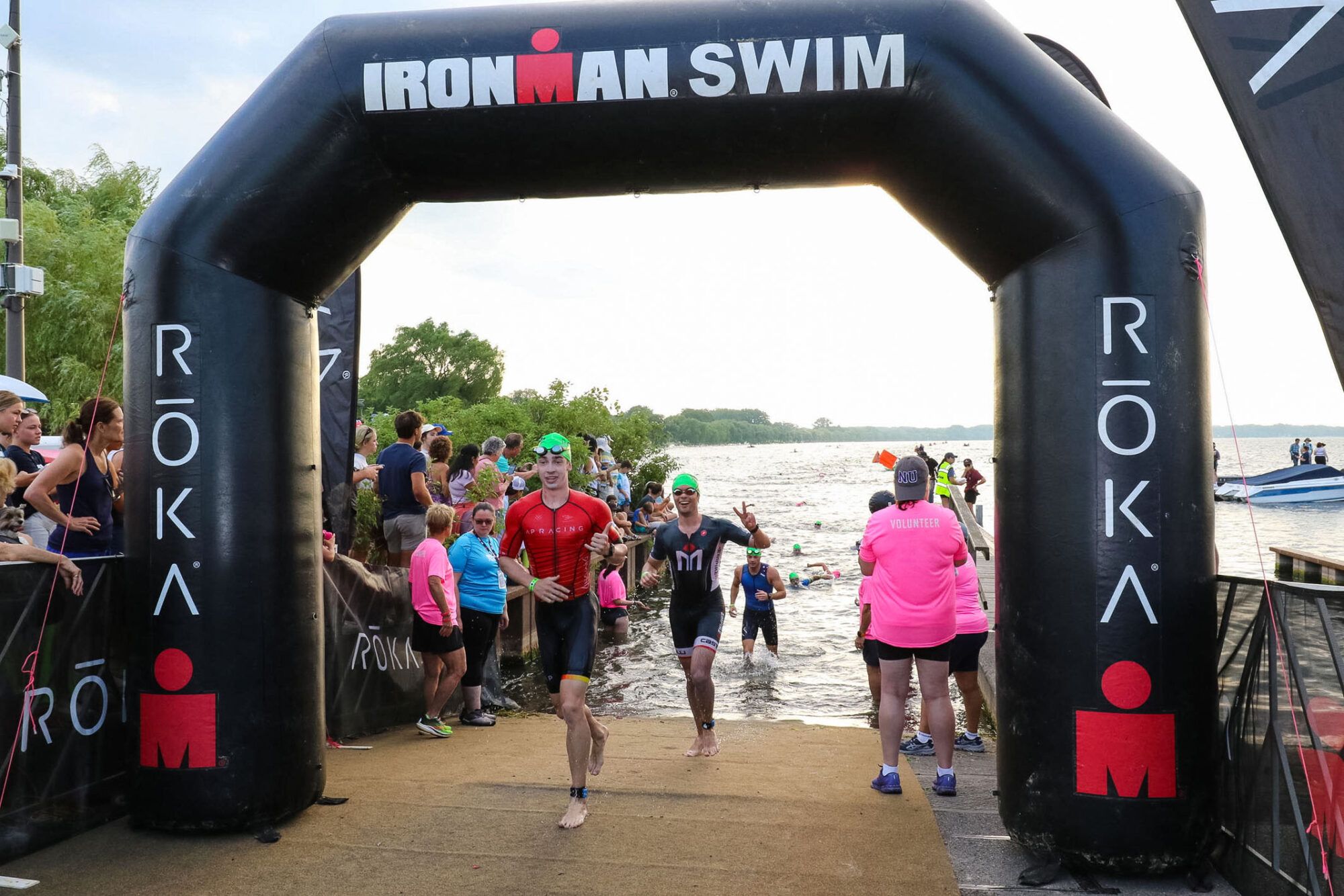
T1
I finished the swim with a time of 42:26. Given the conditions and a lack of a wetsuit, I was incredibly proud of my time, but more importantly, I was happy to finally be out of the water. That was the roughest swim I’ve ever faced!
The swim exit was right next to transition, making for a very fast transition time. As I fumbled with my helmet, I chatted with the guy next to me about how chaotic that swim was, wished him well, and was off on the bike.
The Bike: 56 Miles
The bike course was everything I could’ve asked for. Musselman 70.3 features plenty of flat segments to crush the pace, along with rolling hills to break up the monotony, and beautiful scenery of the Finger Lakes region.
We biked past open farmland reminiscent of where we train back home, to shaded sections along the water as we cycled both up and down alongside some of the surrounding lakes. The calm bike conditions were a stark contrast from the chaotic swim we had just survived, and a fresh change of pace.
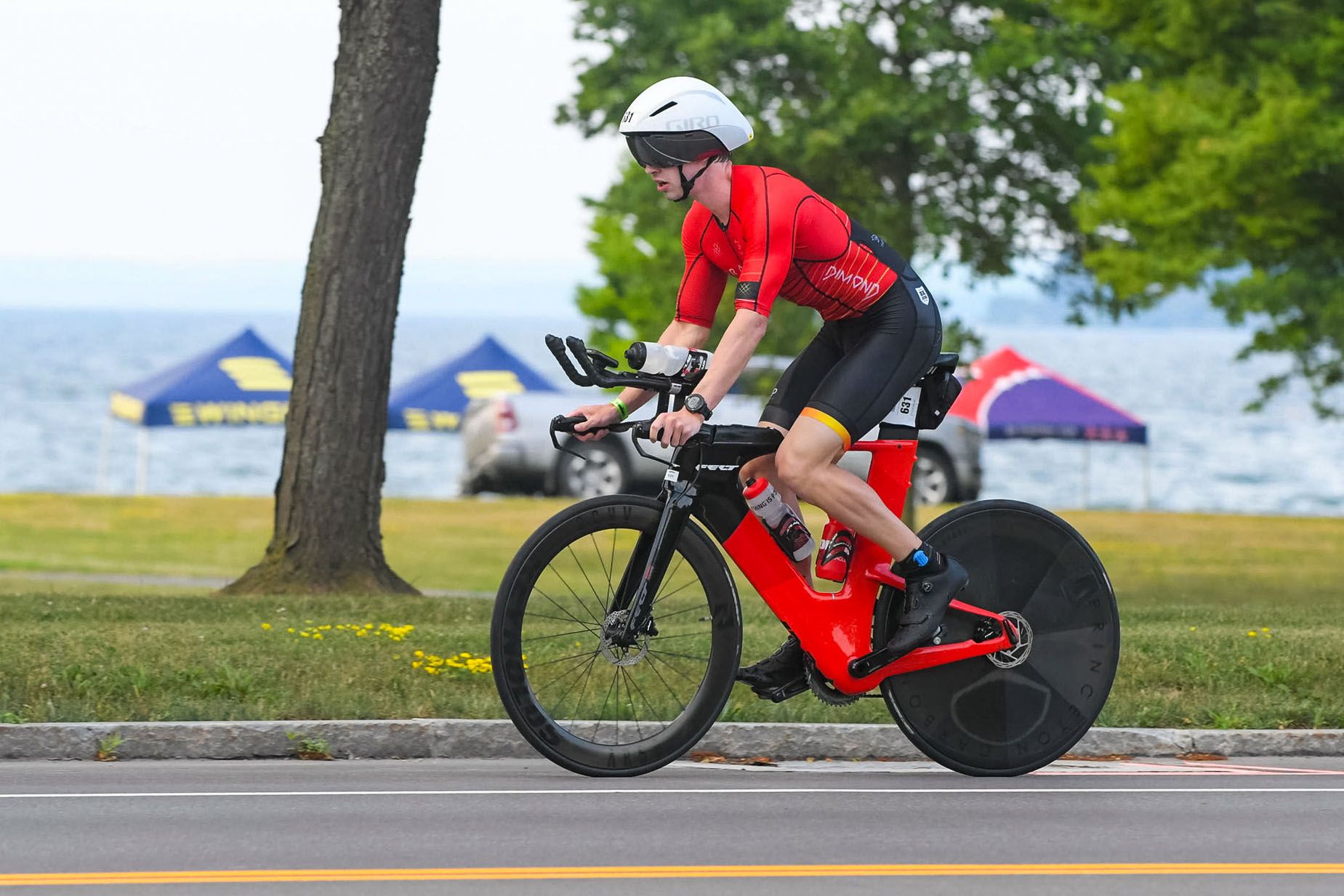
My gameplan for the bike was to take the first 10 miles easy to warm up the legs and conserve energy for some of the larger climbs later in the ride. I stuck with the pack, staying a bit below my desired power target, and felt amazing. This area of the course was beautiful, as we cycled through open countryside illuminated by the soft morning glow.
The middle portion of the bike leg was all about maintaining pace, picking off other athletes, and pushing strong up the hills. I was able to stay in the aero position for long stretches of time, tucking in to avoid the headwinds we were getting. You’ll ride along a lengthy stretch down by the water that stays mostly flat, along with plenty of shade to keep you cool.
Expect the largest climbs as you near miles 30 and 35. I was met with a gradual but long uphill climb, but nothing too dramatic. As long as you saved energy to prepare for these climbs earlier in the race, you’ll have no problem making it up these hills. These are also the last real hill climbs of the bike course, except for one small hill near the finish.
I had plenty of energy to give, so I pushed out of aero, climbing out of the saddle as I crested the hill, and saw a giant expanse of farmland open up around me. Ahead was a nice long downhill that seemed to stretch for miles, a beautiful sight for all the athletes. It was time to reap the rewards of that hill climb.
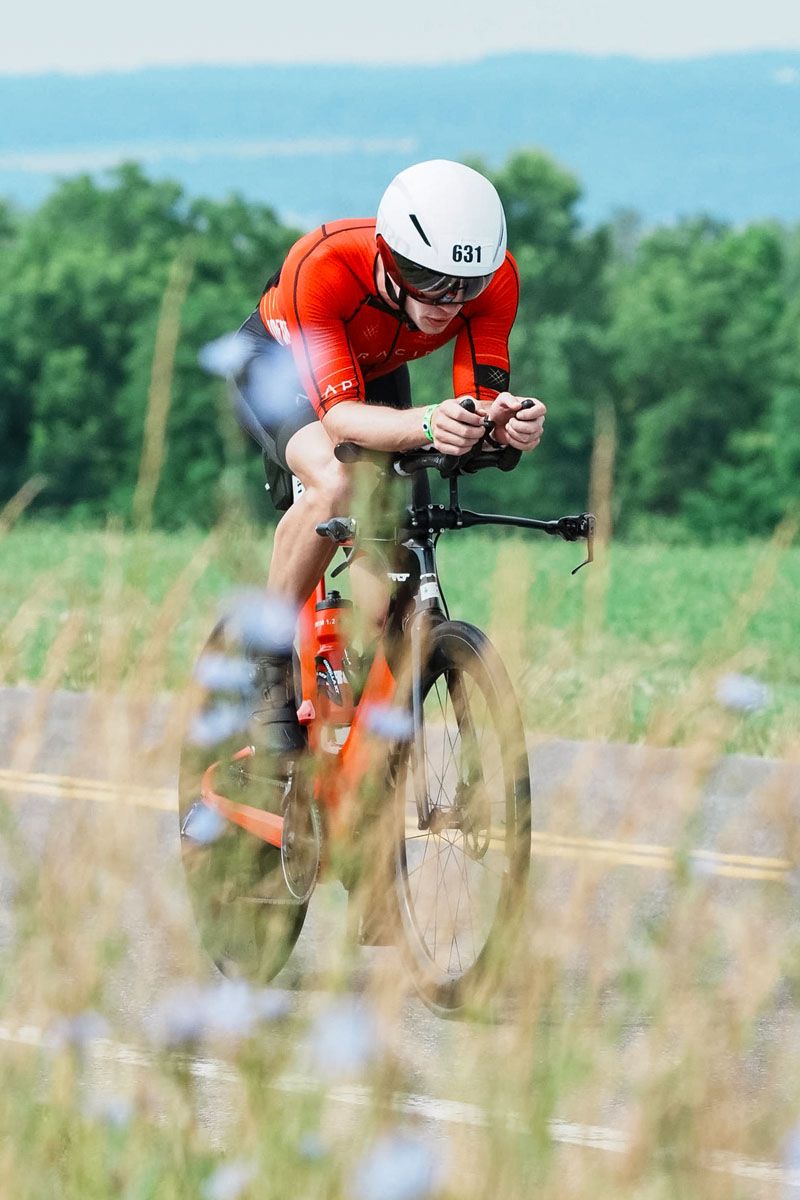
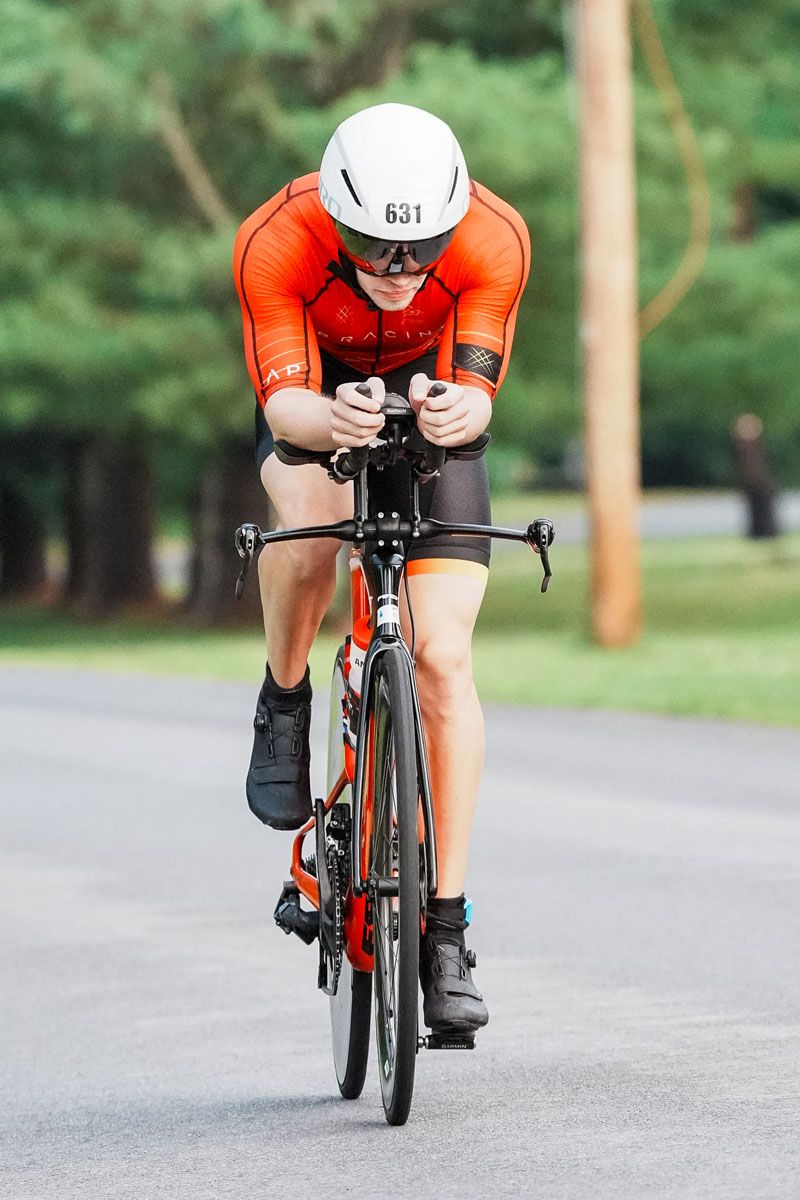
The final 20 miles of the bike course are extremely fast, with either a slight downhill or a flat, shaded road with a tailwind. I could keep solid momentum the entire time, staying in aero and just pushing power. Since I saved my energy earlier in the race, I had plenty of power to give here. I was flying down the road as I emptied the tank, which was so much fun! Over these last 20 miles, I averaged 26.5 mph as I cruised past other competitors, and before I knew it, I was back at transition.
I finished the bike with a time of 2:24, 4th in my age group with an average pace of 23.4 mph.
Note: Wind conditions can change from year to year. It’s important to study the course ahead of time, as well as look at the weather on race day to see which direction the wind will be coming. This can help you plan your optimal race strategy.
T2
Running into transition, it’s always a great sight to see only a small minority of bikes are racked. That meant that I was up with the big dogs now, the fast athletes that were all looking to place on the podium in their age group. I racked my bike, swapped my cycle shoes for my pre-tied run shoes, and put on my hat, shades, and race belt as I ran out through transition.
The Run: 13.1 Miles
The first few miles went great. I was steady at my ideal pace, felt great, and focused on quick leg turnover. It was also flat and shaded, which helped a lot. But the heat was getting to me. I could feel it slowly sucking the remaining energy out of my body, not a great feeling when you’ve still got over an hour of intense running to go. At each aid station I’d grab a few cups of cold water, splashing my face, chest, and back as a way to keep the heat at bay.
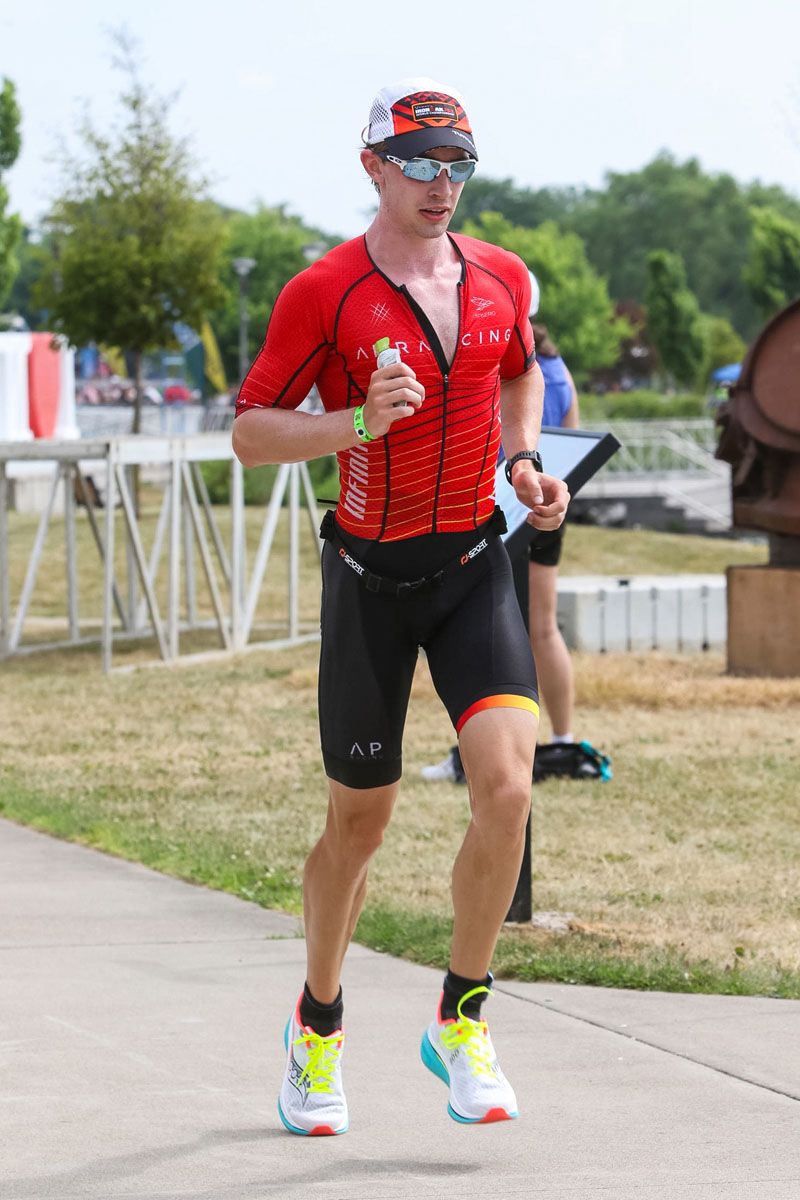
Musselman 70.3 features a 2-loop run course, meaning you run the same 6-ish mile loop twice. On this loop was one large hill just outside town, with a long hot climb. I had run the hill the day before with no problems, until I made it to the same hill on race day.
My legs were tired from the bike, my body exhausted, and this hill was not to be trifled with. A lot of people walked it, but even though my pace plummeted, I kept telling myself not to stop running. Each time I’d make it to the top exhausted, with each rep sucking more mental energy out of my system. I still managed to settle back into my regular pace, since luckily it was flat at the top, but my legs were certainly feeling the burn.
At each aid station I’d take a quick 5 seconds to walk and drink, partly so I didn’t choke down the cola I was drinking, but also because it gave me a short rest. This quick walk break became longer and longer with each aid station, to the point where, at the end of the run, 10 minutes from the finish, I just had to stop in the shade and just gather my thoughts.
I had never felt this bad mentally in a race before. The heat and the hill had totally zapped my energy, like I was running on reserve power. The only thing that had got me moving again was the goal of a sub 4:50 finish. If I waited around any longer, I’d risk throwing away all the hard work I put in on the bike and early stages of the run. I perked myself back up, numbing the pain in the back of my head, and just put one foot in front of the other. The closer I got to the finish, the easier it felt. I knew I was a handful of minutes away from being able to sit down, which was all the motivation I needed.
Crowd support near the finish was amazing too. You’d run along the waterfront with plenty of spectators lining the pathway cheering you on. I made the final turn to the finish chute, and had that long, carpeted stretch all to myself. I picked up the pace, sailed down the chute, and crossed the finish line at a time of 4 hours, 48 minutes. Crushed it!
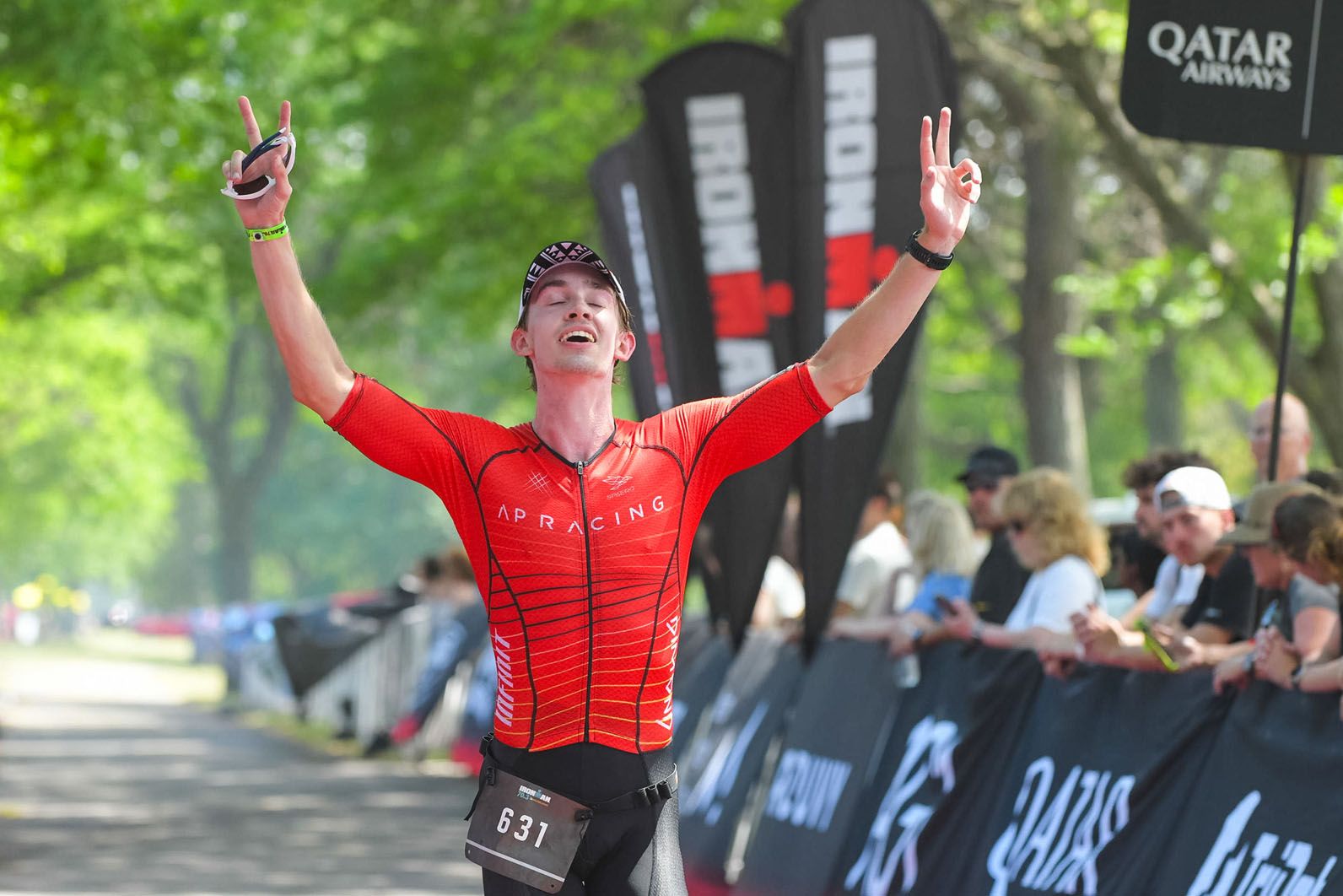
Although not the run I envisioned, I still walked away with a great overall performance and hit my goal of a sub 4:50 finish time. My time put me 48th overall out of over 1,400 people, my best placement I’ve had in a 70.3 race thus far!
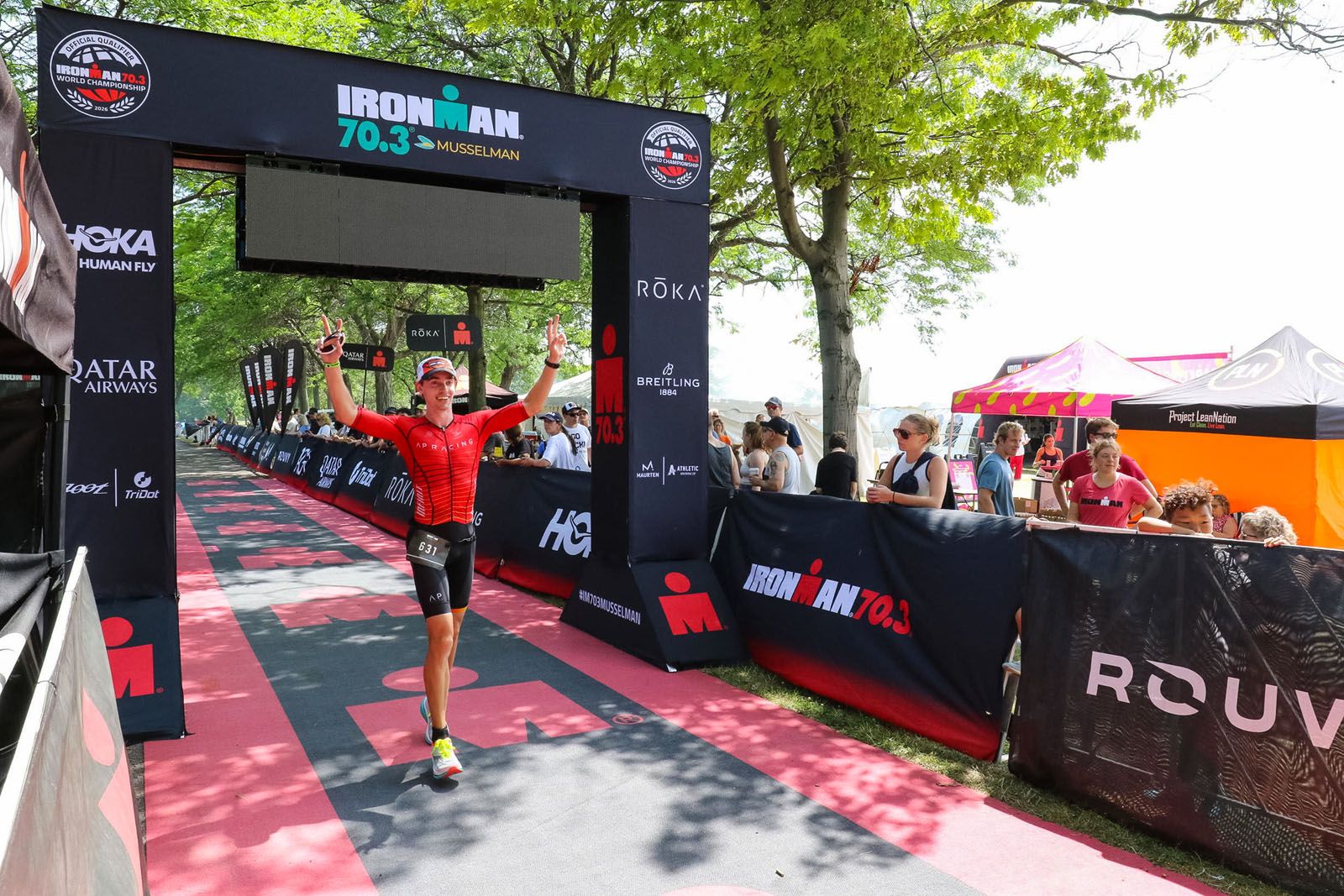
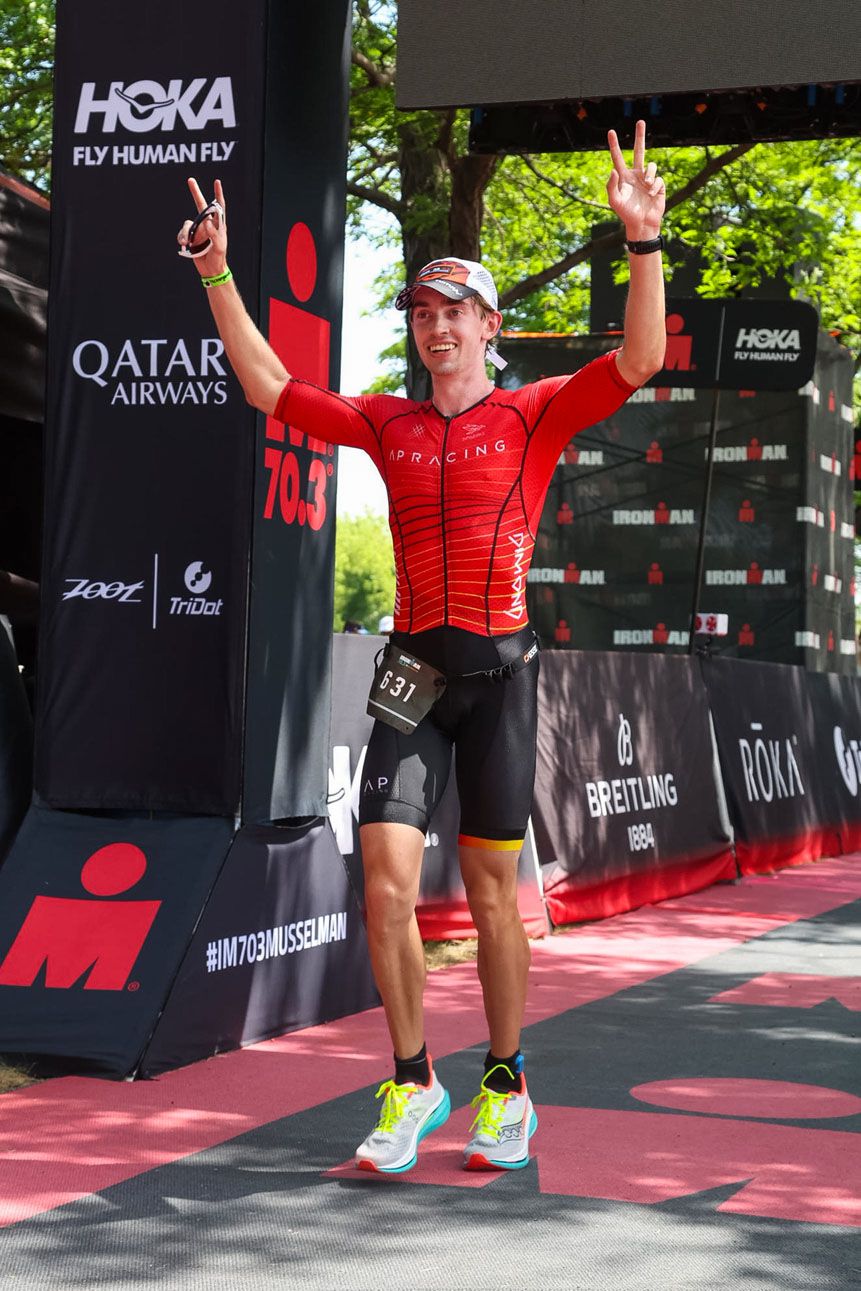
Musselman 70.3 Race Summary
Overall, this was an excellent course and a well-run event. The swim and run courses are spectator friendly, and with transition located near the edge of town, there’s plenty of hotels and restaurants just a short walk away. You also get great spectator and volunteer support throughout the race.
Although race day conditions for us were abnormal and a challenge, that wouldn’t stop me from signing up to race again. The bike course is beautiful and fast, riding along smooth roads with changes in scenery to break up any monotony. Apart from the one large hill, the run course is flat with plenty of shade, a welcome relief on any hot days. We’ve heard the swim is usually quite calm, with great visibility within the water. We just got unlucky with the winds which caused such crazy chop on race morning.
As it turns out, both me and Julie secured one of the slots for the 2026 IRONMAN 70.3 World Championship, which is being held in Nice, France! We were ecstatic when they called our names, with little expectation that we would be walking away with a slot. All that hard work paid off!
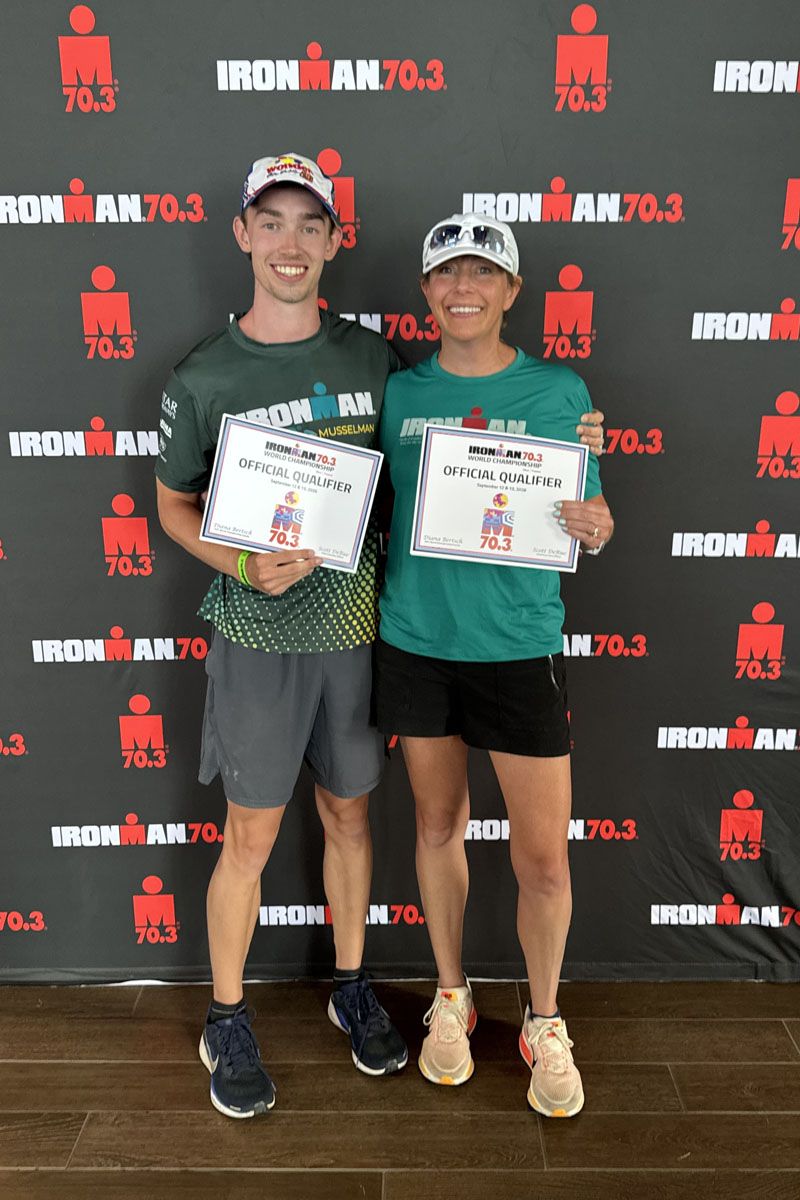
Where to Eat
Kindred Fare: This is our favorite restaurant in Geneva and we dined here several times. On the menu are salads, burgers, several different versions of French fries, steak, chicken, and salmon. On race weekend, they had a ragu pasta on special that was incredible.
Cosentino’s Ristorante: Italian restaurant in Geneva that overall gets good reviews but service can be slow.
Torrey Park Restaurant: Highly rated Italian restaurant on the outskirts of Geneva.
The Rusty Pig: Burgers and huge, decadent sandwiches are on the menu, making this a great spot for a post-race meal.
F.L.X. Table: A good option if you are looking for a fine dining experience.
Where to Stay
Before we get into where to stay, it is important to know that race event parking is at Seneca Lake Park. It is roughly a one mile walk from this parking lot and transition. If you aren’t staying within walking distance of transition, you will need to allow time to drive to this lot and walk to transition for check-in and on race morning.
Hampton Inn Geneva: This is the closest hotel to transition, just 0.2 miles away. The review scores are mediocre, as it could use some updating and there are noise complaints from the neighboring train tracks and bar. We stayed here, and agree some refurbishment is necessary, but we had no issues with noise. We stayed on the side of the hotel that overlooked the train tracks and during our stay, the train never ran at night, only during the day, and even then it wasn’t loud. We can’t comment on the noise from the bar, since we stayed on the other side of the hotel, but that also didn’t look like an issue. If we race Musselman again, we’d stay here, since it was so convenient to Ironman village, transition, and getting in a practice swim.
41 Lakefront Hotel: This is the official race hotel. It’s a 0.4 mile walk to transition and gets slightly better reviews than the Hampton Inn. It was sold out when we made our travel arrangements.
The Flatts at North Shore: This very small property is a 0.5 mile walk from transition and gets great reviews.
Fairfield Inn & Suites Geneva Finger Lakes: This chain hotel gets decent reviews but is 1.7 miles from transition.
Holiday Inn Express & Suites Geneva Finger Lakes: 2.2 miles from transition but within walking distance of our favorite restaurant, Kindred Fare.
Three more properties that get excellent review scores but are a short drive from transition include the Fallen Tree Inn, William Smith Inn, and Sailwinds B&B.
Things to Do Before or After the Race
We spent three days in the Finger Lakes after the race, visiting vineyards, small towns, and Watkins Glen. If you like the idea of adding on short but scenic hikes through waterfalls, wine tastings, and photographing waterfalls, consider adding on a day or two to explore the Finger Lakes after your race.
Official Race Website
To register for the race, get detailed course information, and more, visit the official IRONMAN website.
If you have any questions about racing IRONMAN 70.3 Musselman or if you want to share your experience, let us know in the comment section below.
More Triathlons & Travel Ideas
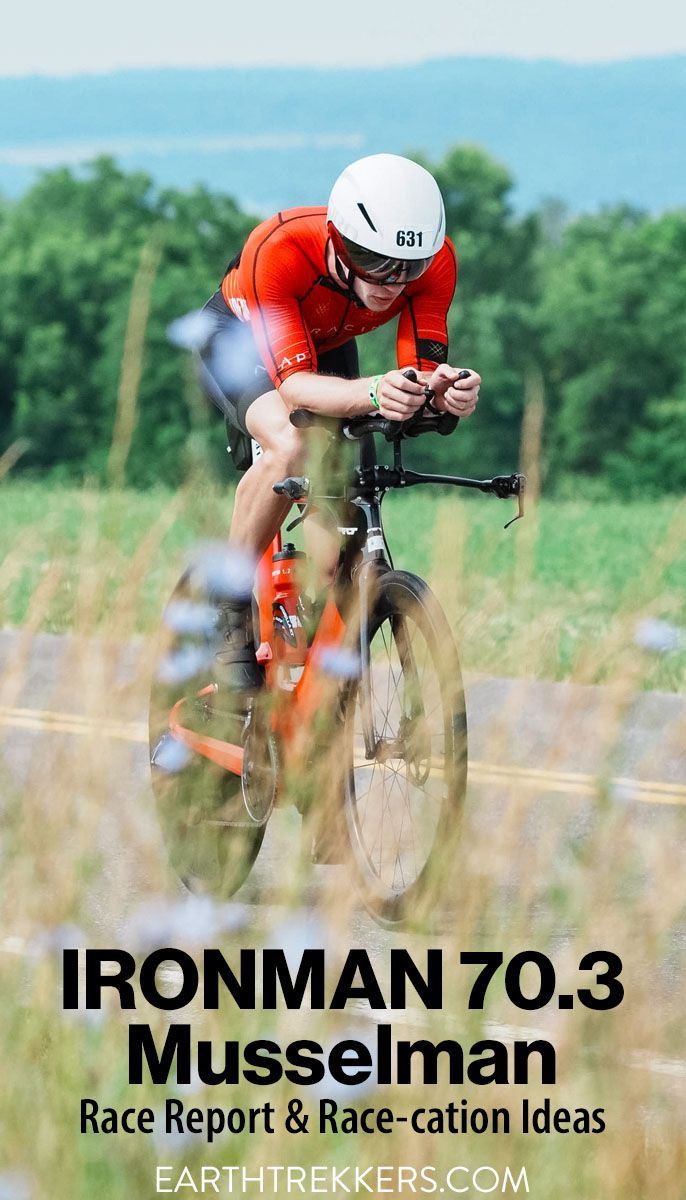
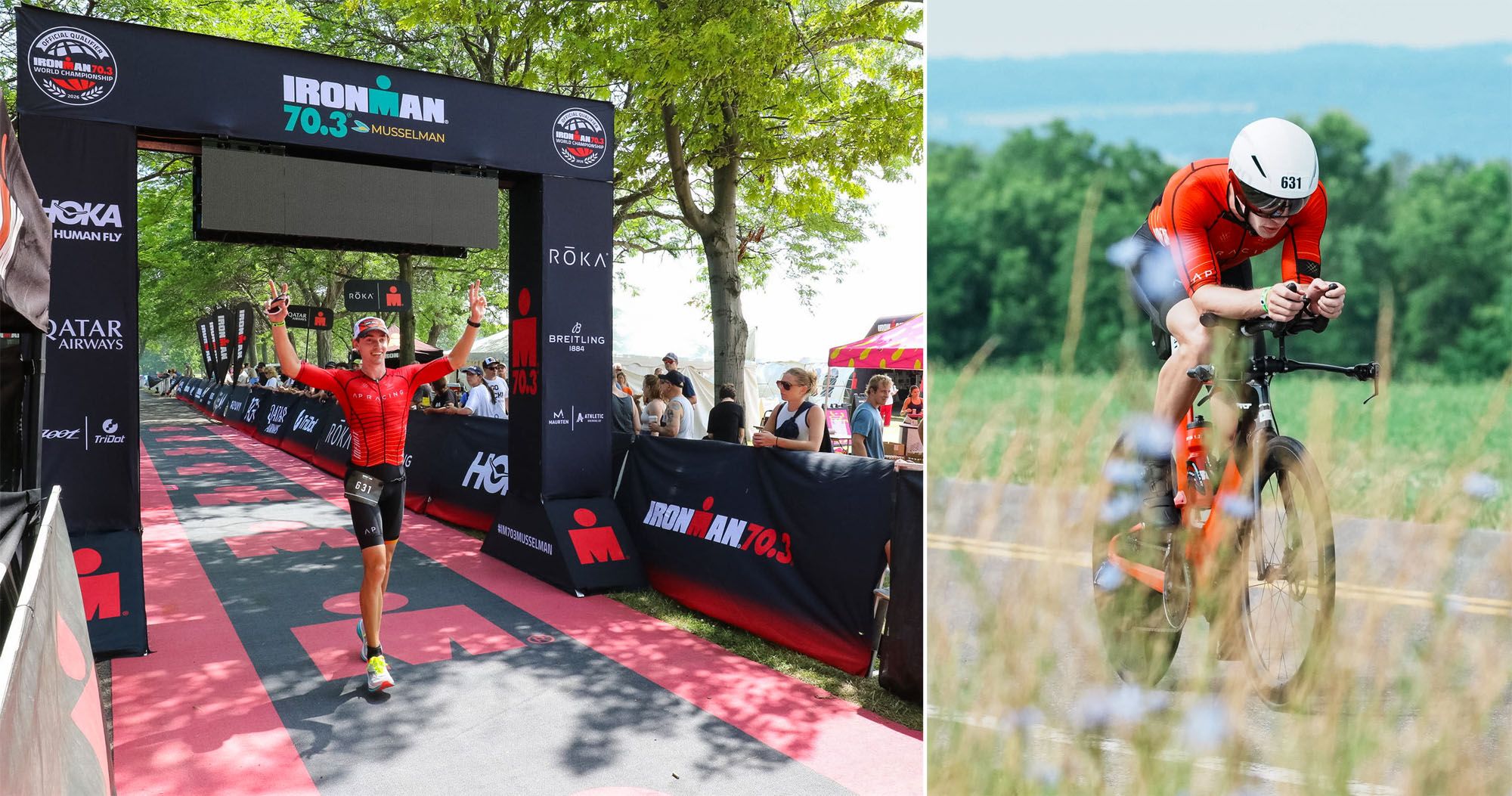
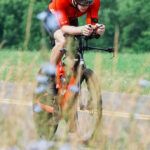

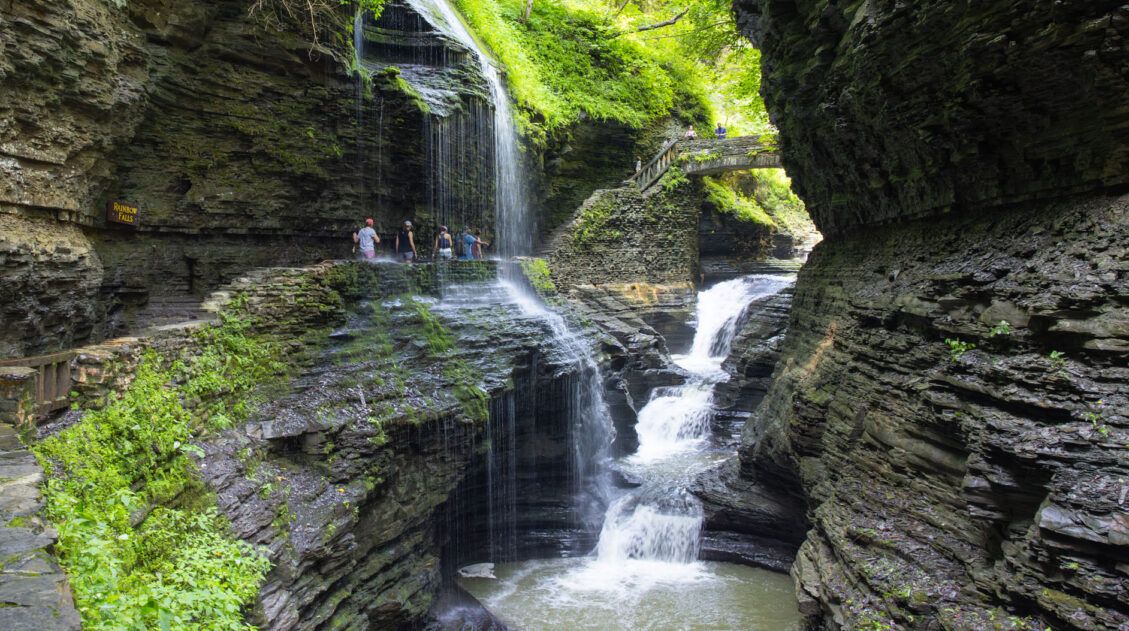
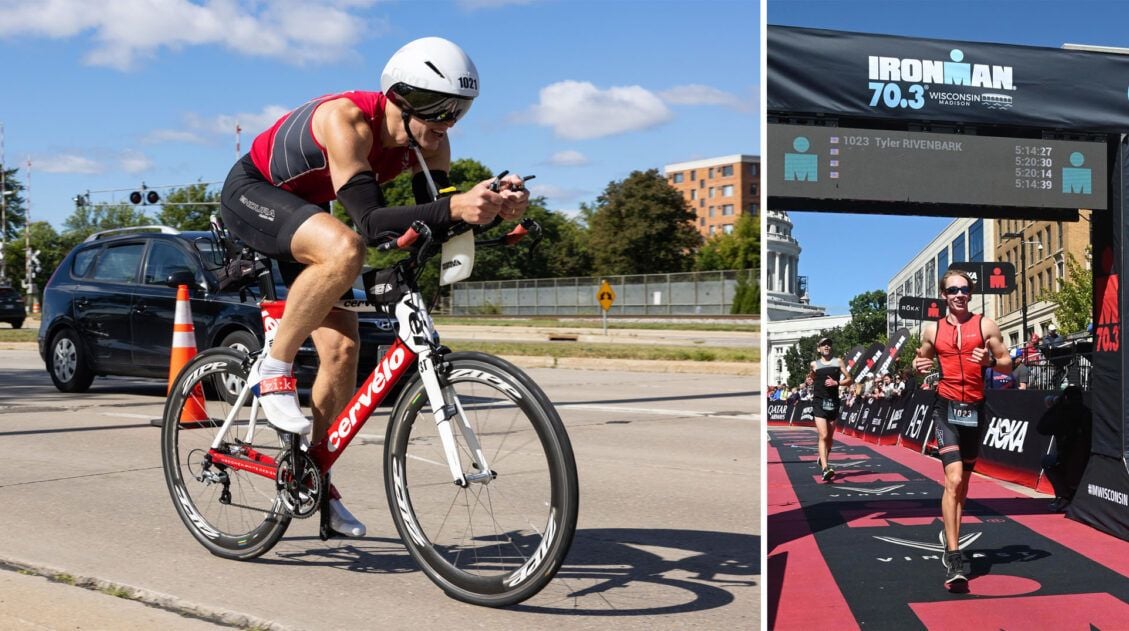
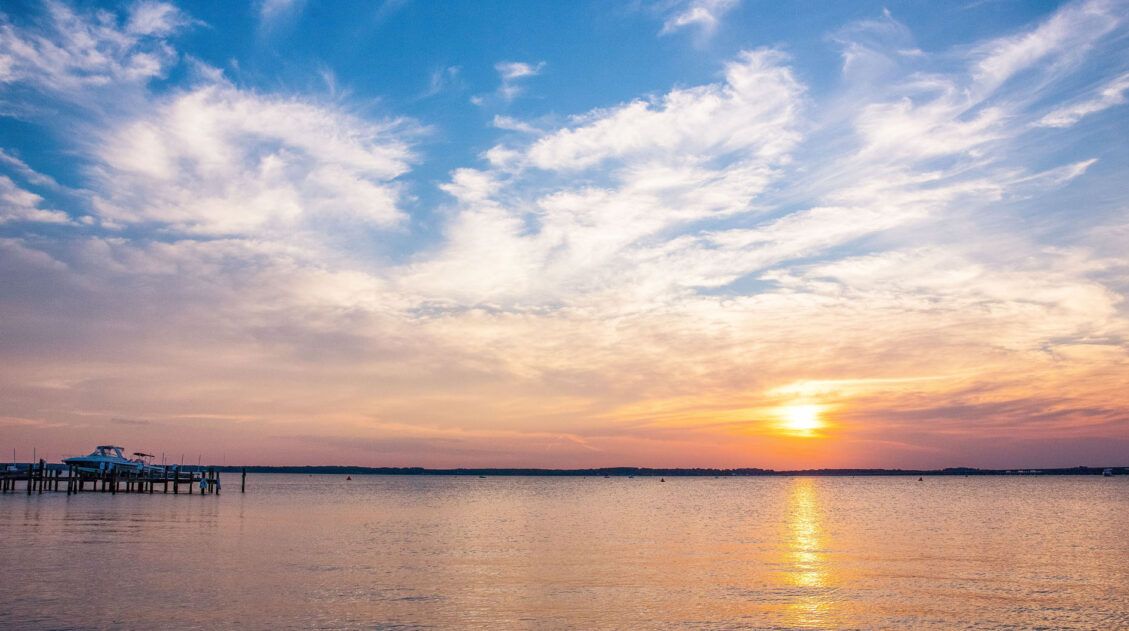
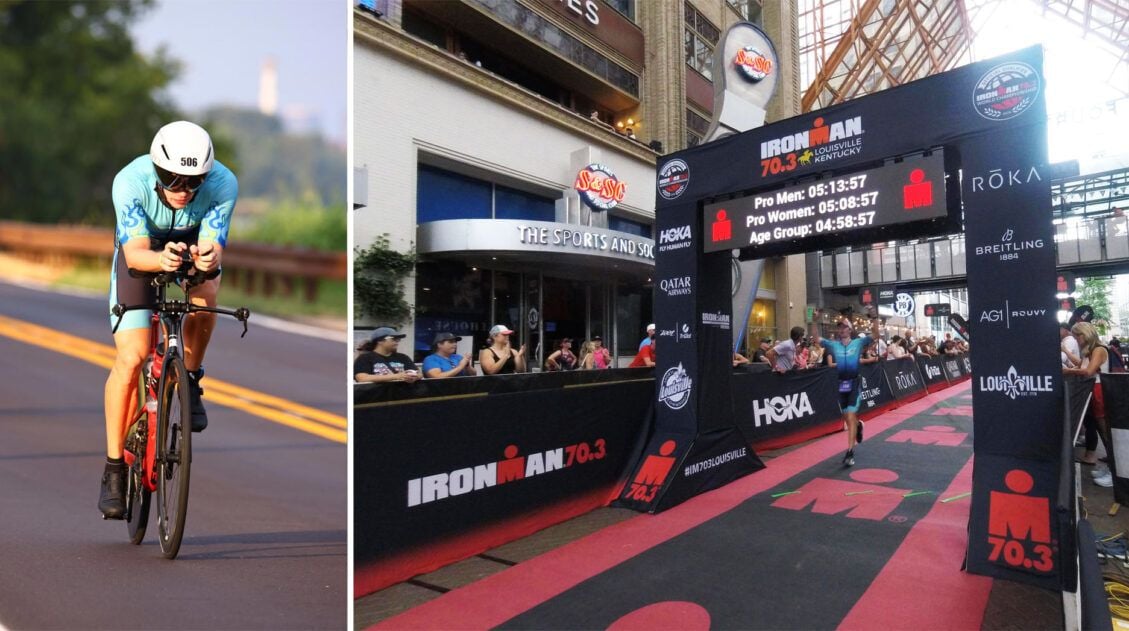
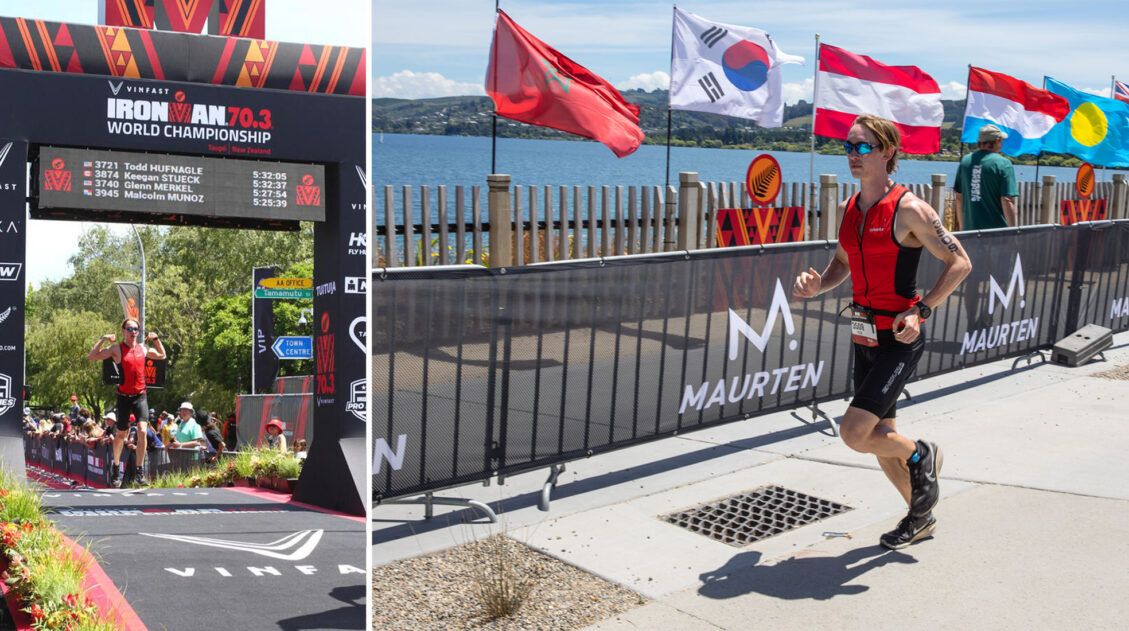
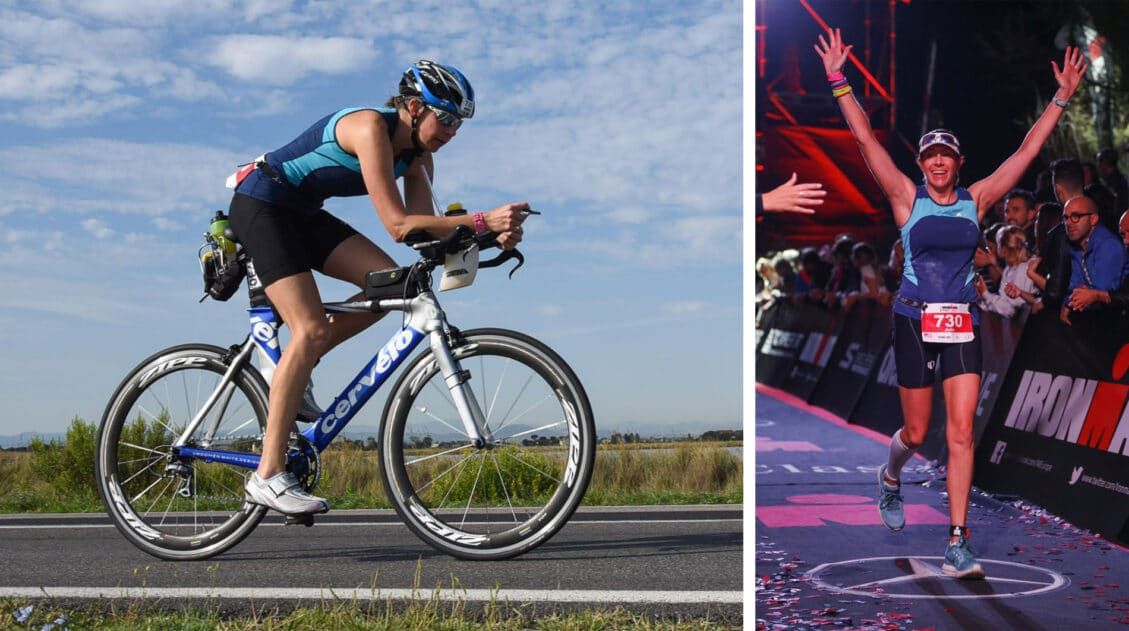
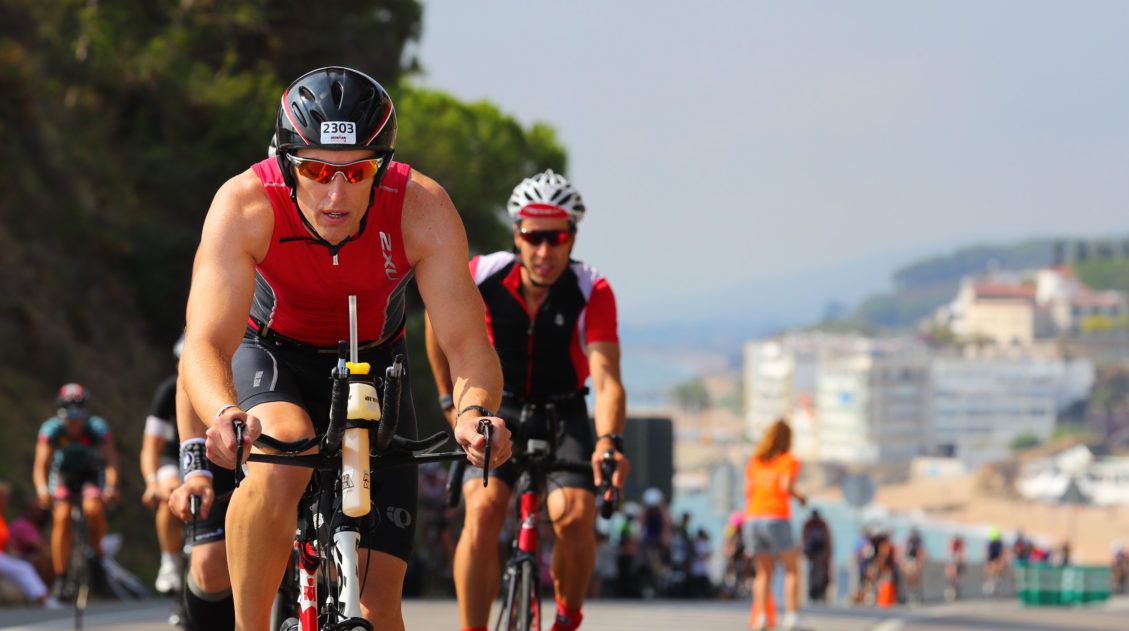



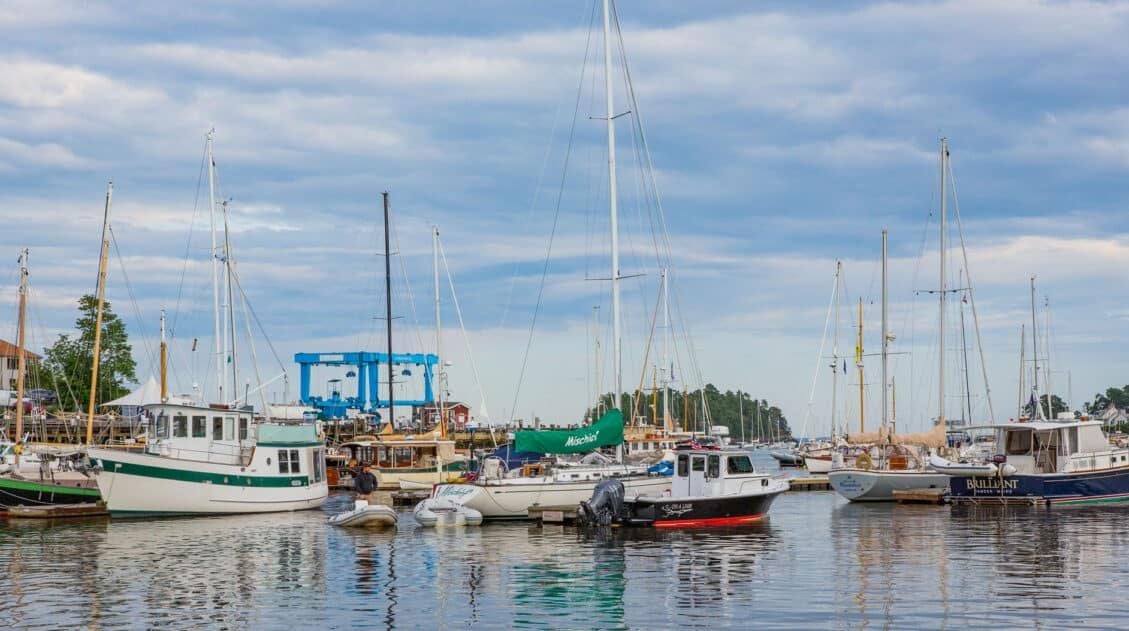
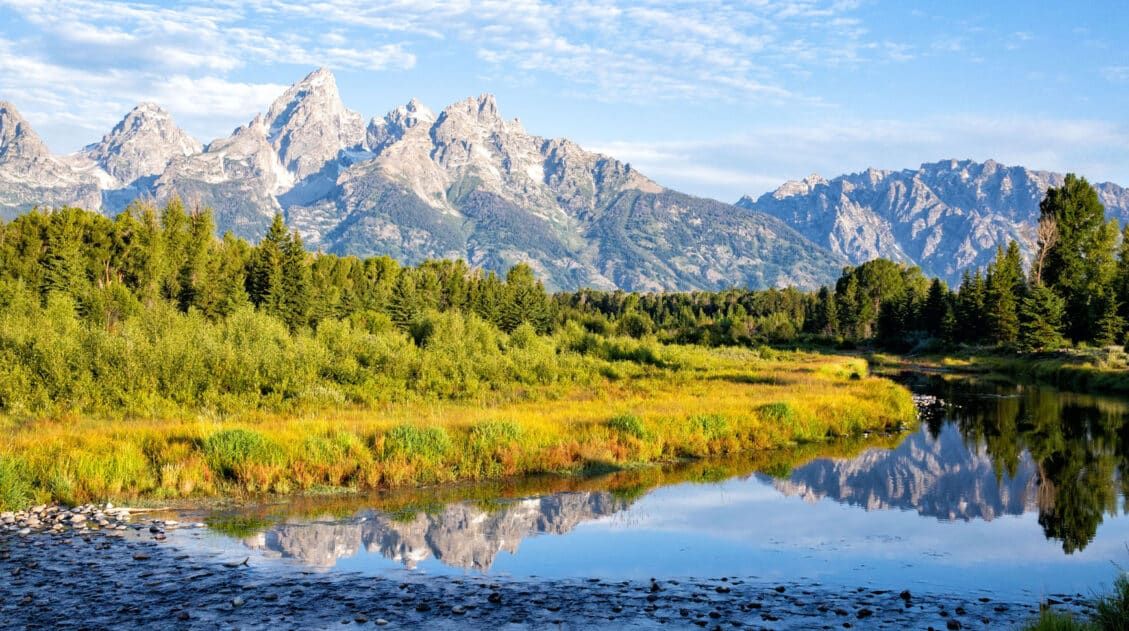
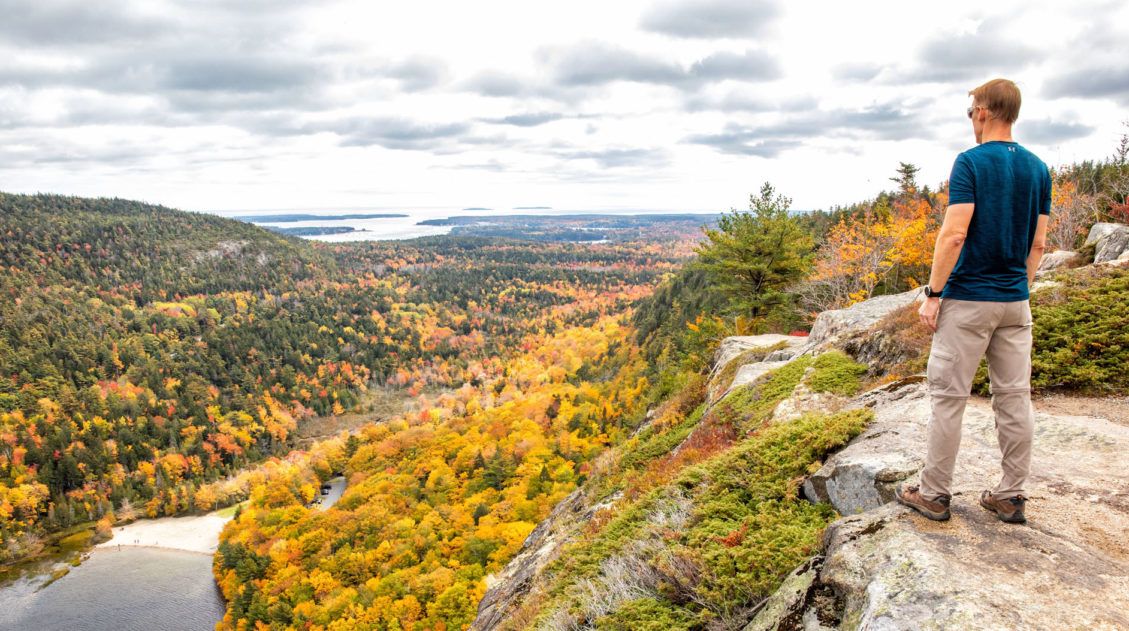

Comments 2